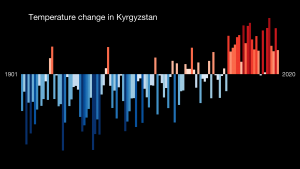The climate is the most important continuously operating factor of the natural environment, which daily affects the living conditions and life of people.
This picture shows the so-called warming bands in Kyrgyzstan, which clearly demonstrate the change in temperature in our country from 1901 to 2020.

Each colored bar represents the average temperature for the year: blue for colder years, red for warmer years.
Here you can clearly see how, after 2000, an increase in temperature regimes was increasingly observed on the territory of our country.
According to the database of the environmental organization Move Green, which is a member of the Green Alliance of Kyrgyzstan, over the past 43 years, a widespread increase in the average annual air temperature has been observed in Kyrgyzstan – an average of 0.22 degrees Celsius every 10 years. At the same time, the global temperature increase over the same period was slightly lower – 0.17 degrees Celsius.
In general, for Kyrgyzstan, the last 20 years have been the hottest on record.
Since 1997, the average temperature in Kyrgyzstan has only been slightly below normal three times: in 2003, 2012 and 2014. The hottest year since 1976 is 2016, when the annual temperature in the republic was above the norm by 1.19 degrees Celsius.
In the spring period, the most intensive rates of warming are observed – an average of 0.4 degrees every ten years. The highest rates of warming are recorded in the valley and foothill zones of the Chui region and the valley zone of the Talas region. In winter and autumn, the rate of increase in air temperature is somewhat lower than in spring. At the same time, in the winter period in the southern regions of Kyrgyzstan, it warms up somewhat faster.
According to the Ministry of Emergency Situations, there has been a steady increase in the number of emergencies in Kyrgyzstan over the past 30 years. During this time, almost 6 thousand various disasters occurred in the country. Two-thirds of them are natural emergencies. The Ministry of Emergency Situations notes that the melting of glaciers, the disappearance of permafrost zones and the decrease in snow cover will lead to a reduction in water resources in Central Asia. Moreover, high temperatures and heavy rainfall can trigger frequent and severe natural disasters such as drought, heat waves, floods, landslides, mudflows and avalanches.
The problem of reducing glaciation is, by and large, the number one problem not only for the Republic, but also for the Central Asian region, as well as for the planet and the world community as a whole. Currently, there is a widespread reduction in glaciation.
Both the direct bioclimatic conditions of the life of the population of Kyrgyzstan and the entire economic activity of the Republic will depend on the climatic conditions of the near future, on their changes. Understanding the importance of the current assessment and future climate changes for the development of the republic and, in particular, its mountainous territories, dictates the urgency of solving problems related to the dynamics of the climate situation.
Warming will manifest itself not only in the evolution of glaciation and the volume of glacial runoff, but the overall runoff will change – it will decrease. An increase in air temperature by 1° leads to an increase in the intensity of evaporation by 16%, and this, even against the background of maintaining the norm of precipitation, not to mention its decrease, will be accompanied by a decrease in the water content of rivers.
In this regard, support from the state and understanding of the importance of topics on future climate change is very important. Leading experts in this field, as well as members of the Green Alliance of Kyrgyzstan, are constantly taking measures aimed at reducing the negative effects of climate change.
On December 12, 2015 in Paris, 196 parties to the United Nations Framework Convention on Climate Change unanimously adopted the Paris Agreement, a new agreement under the United Nations Framework Convention on Climate Change.
Kyrgyzstan is no exception. And already in 2019, he ratified the Paris Agreement. The Agreement replaced the Kyoto Protocol and strengthened the activities that countries carry out under the Convention as a whole. It officially entered into force on November 4, 2016 and consolidated the basic principles for the actions of all states for the period from 2020.
Using the problem of climate change as a catalyst, by joining the Paris Agreement, Kyrgyzstan will accelerate the process of achieving the Sustainable Development Goals, contributing to the achievement of adaptation targets. However, the planned economic development will inevitably lead to an increase in greenhouse gas emissions, and here our task is to try at least not to exceed the level of emissions
The position of the Civil Society of the Kyrgyz Republic on the occasion of the 26th Conference of the Parties to the UN Framework Convention on Climate Change has been prepared. It was presented to the general public and published in the leading mass media of Kyrgyzstan.
The document also included specific actions in line with the level of ambition set out in Nationally Determined Contributions (NDCs) under the Paris Agreement on Climate Change.